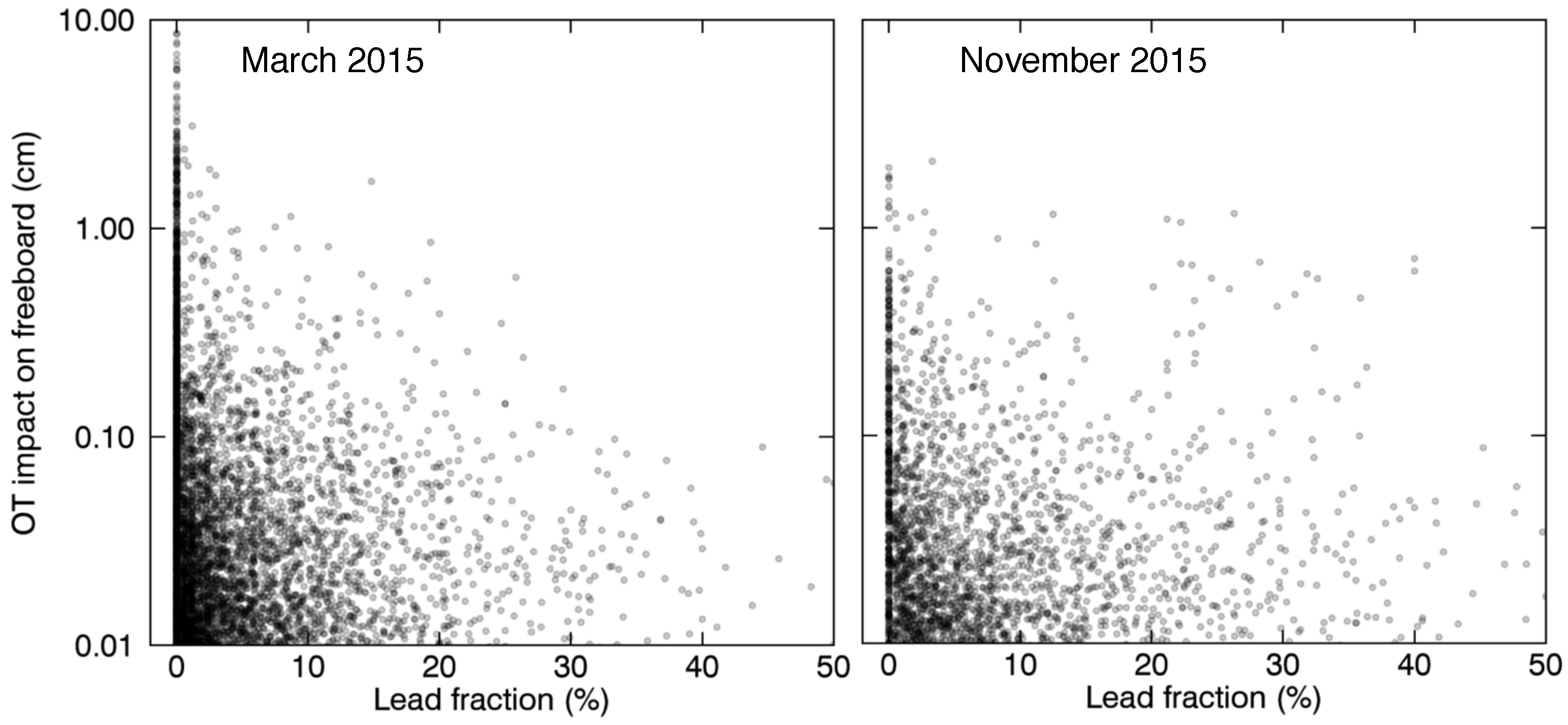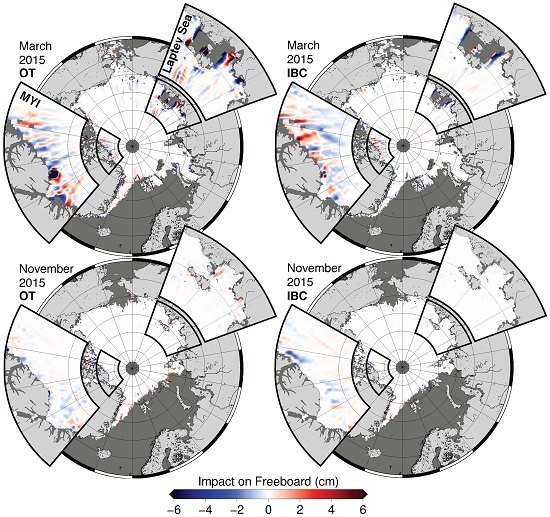The Impact of Geophysical Corrections on Sea-Ice Freeboard Retrieved from Satellite Altimetry
Abstract
:1. Introduction
2. Data and Methods
2.1. Geophysical Range Corrections
2.1.1. Ocean Tide (OT)
2.1.2. Geocentric Polar Tide (GPT)
2.1.3. Solid Earth Tide (SET)
2.1.4. Long-Period Equilibrium Tide (LPET)
2.1.5. Ocean Loading Tide (OLT)
2.1.6. Dry Tropospheric Correction (DTC)
2.1.7. Wet Tropospheric Correction (WTC)
2.1.8. Ionospheric Correction (IC)
2.1.9. Inverse Barometric Correction (IBC) and Dynamic Atmosphere (DAC)
2.2. The Impact of Geophysical Corrections on Sea-Ice Freeboard
2.2.1. CryoSat-2 Data Retrieval
2.2.2. Experimental Setup
2.3. Airborne Laser Scanner Data and Coincident CryoSat-2 Freeboard
3. Results
3.1. Assessing the Impact of Geophysical Corrections on Sea-Ice Freeboard
3.2. Comparison with Coincident Airborne Laser Scanner Measurements
4. Discussion
4.1. Assessing the Impact of Geophysical Corrections on Sea-Ice Freeboard
4.2. Comparison with Coincident Airborne Laser Scanner Measurements
4.3. Uncertainties in the Experimental Setup and Advices
5. Conclusions
Acknowledgments
Author Contributions
Conflicts of Interest
Abbreviations
| ALS | Airborne Laser Scanner |
| AWI | Alfred Wegener Institute, Helmholtz Centre for Polar and Marine Research |
| CNES/SSALTO | Centre National D’etudes Spatiales/Segment Sol multi-missions dALTimetrie, d’Orbitographie et de localisation précise |
| CryoVEx | Cryosat Validation Experiment |
| CS2 | CryoSat-2 |
| DEM | Digital Elevation Model |
| DTC | Dry Tropospheric Correction |
| DTU13 | Danish Technical University Mean Sea Surface version 2013 |
| ECMWF | European Centre for Medium-Range Weather Forecasts |
| ESA | European Space Agency |
| Fb | Freeboard |
| FYI | First-Year old sea Ice |
| GIM | Global Ionospheric Map |
| GPS | Global Positioning System |
| GPT | Geocentric Polar Tide |
| IBC | Inverse Barometric Correction |
| IC | Ionospheric Correction |
| LPET | Long-Period Equilibrium Tide |
| MSS | Mean Sea Surface |
| MYI | Multi-Year old sea Ice |
| NC | No Corrections |
| OLT | Ocean Loading Tide |
| OT | Ocean Tide |
| r | Pearson’s Correlation coefficient rmse: root-mean-square error |
| SET | Solid Earth Tide |
| SSA | Sea Surface Anomaly |
| SSHA | Sea Surface Height Anomaly |
| WTC | Wet Tropospheric Correction |
References
- Rothrock, D.A.; Yu, Y.; Maykut, G.A. Thinning of the Arctic sea-ice cover. Geophys. Res. Lett. 1999, 26, 3469–3472. [Google Scholar] [CrossRef]
- Giles, K.A.; Laxon, S.W.; Ridout, A.L. Circumpolar thinning of Arctic sea ice following the 2007 record ice extent minimum. Geophys. Res. Lett. 2008, 35, L22502. [Google Scholar] [CrossRef]
- Kwok, R.; Cunningham, G.F.; Wensnahan, M.; Rigor, I.; Zwally, H.J.; Yi, D. Thinning and volume loss of the Arctic Ocean sea ice cover: 2003–2008. J. Geophys. Res. 2009, 114. [Google Scholar] [CrossRef]
- Lindsay, R.; Schweiger, A. Arctic sea ice thickness loss determined using subsurface, aircraft, and satellite observations. Cryosphere 2015, 9, 269–283. [Google Scholar] [CrossRef]
- Ricker, R.; Hendricks, S.; Helm, V.; Skourup, H.; Davidson, M. Sensitivity of CryoSat-2 Arctic sea-ice freeboard and thickness on radar-waveform interpretation. Cryosphere 2014, 8, 1607–1622. [Google Scholar] [CrossRef] [Green Version]
- Ricker, R.; Hendricks, S.; Gerdes, R.; Helm, V. Classification of CryoSat-2 radar echoes. In Towards an Interdisciplinary Approach in Earth System Science: Advances of a Helmholtz Graduate Research School; Lohmann, G., Ed.; Springer: Berlin, Germany, 2014. [Google Scholar]
- Laxon, S.W.; Giles, K.A.; Ridout, A.L.; Wingham, D.J.; Willatt, R.; Cullen, R.; Kwok, R.; Schweiger, A.; Zhang, J.; Haas, C.; et al. CryoSat-2 estimates of Arctic sea ice thickness and volume. Geophys. Res. Lett. 2013, 40, 732–737. [Google Scholar] [CrossRef]
- Kurtz, N.T.; Galin, N.; Studinger, M. An improved CryoSat-2 sea ice freeboard retrieval algorithm through the use of waveform fitting. Cryosphere 2014, 8, 1217–1237. [Google Scholar] [CrossRef] [Green Version]
- Kwok, R.; Cunningham, G. Variability of Arctic sea ice thickness and volume from CryoSat-2. Philos. Trans. R. Soc. Lond. A: Math. Phys. Eng. Sci. 2015, 373, 20140157. [Google Scholar] [CrossRef] [PubMed]
- Tilling, R.L.; Ridout, A.; Shepherd, A.; Wingham, D.J. Increased Arctic sea ice volume after anomalously low melting in 2013. Nat. Geosci. 2015, 8, 643–646. [Google Scholar] [CrossRef]
- Ricker, R.; Hendricks, S.; Perovich, D.K.; Helm, V.; Gerdes, R. Impact of snow accumulation on CryoSat-2 range retrievals over Arctic sea ice: An observational approach with buoy data. Geophys. Res. Lett. 2015. [Google Scholar] [CrossRef]
- Kwok, R. Simulated effects of a snow layer on retrieval of CryoSat-2 sea ice freeboard. Geophys. Res. Lett. 2014, 41, 5014–5020. [Google Scholar] [CrossRef]
- Skourup, H.; Einarsson, I.; Sandberg, L.; Forsberg, R.; Stenseng, L.; Hendricks, S.; Helm, V.; Davidson, M. ESA CryoVEx 2011 airborne campaign for CryoSat-2 calibration and validation. In Proceedings of the 2011 AGU Fall Meeting, San Francisco, CA, USA, 5–9 September 2011.
- European Space Agency. L1B Products Format Specification; CS-RS-ACS-GS-5106; ESA: Paris, France, 2011. [Google Scholar]
- Lyard, F.; Lefevre, F.; Letellier, T.; Francis, O. Modelling the global ocean tides: Modern insights from FES2004. Ocean Dyn. 2006, 56, 394–415. [Google Scholar] [CrossRef]
- Cartwright, D.; Tayler, R. New computations of the tide-generating potential. Geophys. J. R. Astron. Soc. 1971, 23, 45–74. [Google Scholar] [CrossRef]
- Cartwright, D.; Edden, C. Corrected tables of tidal harmonics. Geophys. J. R. Astron. Soc. 1973, 33, 253–264. [Google Scholar] [CrossRef]
- Jentzsch, G. Earth tides and ocean tidal loading. In Tidal Phenomena; Springer: Berlin, Germany, 1997; pp. 145–171. [Google Scholar]
- Farrell, W.E. Deformation of the Earth by surface loads. Rev. Geophys. 1972, 10, 761–797. [Google Scholar] [CrossRef]
- AVISO+. Available online: http://www.aviso.oceanobs.com/es/data/index.html. (accessed on 21 March 2016).
- Kruizinga, G.L.H. Validation and Applications of Satellite Radar Altimetry; University of Texas: Austin, TX, USA, 1997. [Google Scholar]
- Fu, L.L.; Cazenave, A. Satellite Altimetry and Earth Sciences: A Handbook of Techniques and Applications; Academic Press: New York, NY, USA, 2000. [Google Scholar]
- Wunsch, C.; Stammer, D. Atmospheric loading and the oceanic “inverted barometer” effect. Rev. Geophys. 1997, 35, 79–107. [Google Scholar] [CrossRef]
- Helm, V.; Humbert, A.; Miller, H. Elevation and elevation change of Greenland and Antarctica derived from CryoSat-2. Cryosphere 2014, 8, 1539–1559. [Google Scholar] [CrossRef] [Green Version]
- Andersen, O.; Knudsen, P.; Stenseng, L. The DTU13 MSS (Mean Sea Surface) and MDT (Mean Dynamic Topography) from 20 years of satellite altimetry. In Proceeding of the International Association of Geodesy Symposia, Heidelberg, Germany, 13 August 2015.
- Brodzik, M.J.; Billingsley, B.; Haran, T.; Raup, B.; Savoie, M.H. EASE-Grid 2.0: Incremental but Significant Improvements for Earth-Gridded Data Sets. ISPRS Int. J. Geo-Inf. 2012, 1, 32–45. [Google Scholar] [CrossRef]







| Geophysical Correction | Acronym | March 2015 | November 2015 | ||
|---|---|---|---|---|---|
| A (%) | MEAN(|Δ Fb|) (cm) | A (%) | MEAN(|Δ Fb|) (cm) | ||
| Ocean Tide | OT | 7.17 | 4.85 | 2.33 | 3.19 |
| Geocentric Polar Tide | GPT | 0 | – | 0 | – |
| Solid Earth Tide | SET | 0.05 | 1.37 | 0.01 | 1.53 |
| Long-Period Equilibrium Tide | LPET | 0 | – | 0 | – |
| Ocean Loading Tide | OLT | 0.02 | 1.17 | 0 | – |
| Dry Tropospheric Correction | DTC | 0.27 | 1.42 | 0.06 | 2.23 |
| Wet Tropospheric Correction | WTC | 0.06 | 1.80 | 0.03 | 1.24 |
| Ionospheric Correction | IC | 0 | – | 0 | – |
| Inverse Barometric Correction | IBC | 2.69 | 2.22 | 0.69 | 2.37 |
© 2016 by the authors; licensee MDPI, Basel, Switzerland. This article is an open access article distributed under the terms and conditions of the Creative Commons by Attribution (CC-BY) license (http://creativecommons.org/licenses/by/4.0/).
Share and Cite
Ricker, R.; Hendricks, S.; Beckers, J.F. The Impact of Geophysical Corrections on Sea-Ice Freeboard Retrieved from Satellite Altimetry. Remote Sens. 2016, 8, 317. https://doi.org/10.3390/rs8040317
Ricker R, Hendricks S, Beckers JF. The Impact of Geophysical Corrections on Sea-Ice Freeboard Retrieved from Satellite Altimetry. Remote Sensing. 2016; 8(4):317. https://doi.org/10.3390/rs8040317
Chicago/Turabian StyleRicker, Robert, Stefan Hendricks, and Justin F. Beckers. 2016. "The Impact of Geophysical Corrections on Sea-Ice Freeboard Retrieved from Satellite Altimetry" Remote Sensing 8, no. 4: 317. https://doi.org/10.3390/rs8040317







